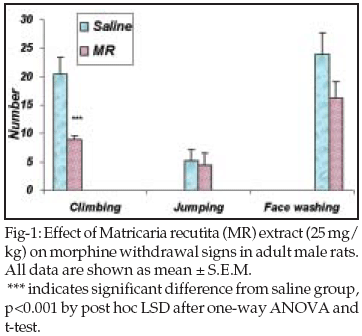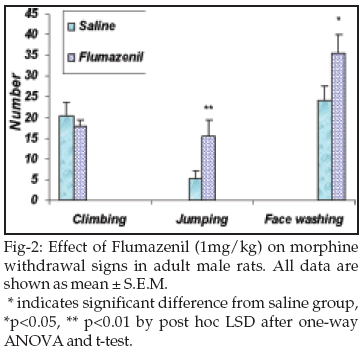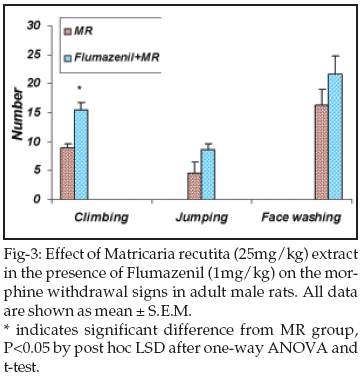Study of benzodiazepine like effects of
Matricaria recutita
on morphine withdrawal syndrome in adult male rats
Kesmati M¹, Abbasi Zadeh Z2, Fathi Moghaddam H3
ABSTRACT
Some studies have shown that Matricaria recutita (M.
recutita) have sedative effect on pain, anxiety and morphine withdrawal
syndrome (MWS). Since some investigations have indicated the sedative
effects of benzodiazepines in MWS, so the inhibitory factor of M.
recutita may be related to some of its benzodiazepine-like components.
In this study sedative properties of M. recutita in the presence and
absence of flumazenil as a benzodiazepine receptors antagonist in MWS were
investigated.
In this study Wistar male adult rats (250±20gr) were
used. Using a vial morphine sulfate solution, morphine dependence induced
with increasing doses injection subcutaneously at six days and on day seven
the last dose was injected. Then four hours later Naloxone (3mg/kg, i.p.)
was injected for induction of morphine withdrawal syndrome. In each group,
the withdrawal signs of climbing, jumping and face washing were measured for
half an hour immediately in presence and absence of M. recutita
extract (25mg/kg) and Flumazenil (1mg/kg).
M. recutita decreased significantly the number of
climbing in comparison to control group (P<0.001), but it had not
significant effect on other signs. Flumazenil increased significantly the
signs of jumping (P<0.01), face washing (P<0.05) in comparison to control
group. M. recutita in the presence of flumazenil had not sedative
effect and the climbing behavior increased significantly (P<0.05). The
sedative effect of M. recutita on morphine withdrawal syndrome is
probably related to it’s benzodiazepine like components that act on
benzodiazepine receptors.
KEY WORDS: Benzodiazepine Matricaria recutita,
Morphine withdrawal syndrome, Flumazenil.
Pak J Med Sci October - December 2008
(Part-I) Vol. 24 No. 5 735-739
How to cite this article:
Kesmati M, Abbasi ZZ, Fathi MH. Study of benzodiazepine like effects of
Matricaria recutita on morphine withdrawal syndrome in adult male
rats. Pak J Med Sci 2008;24(5):735-39.
1. Kesmati M, PhD,
Associate Professor, Dept. of Biology,
College of Sciences,
2. Abbasi Zadeh Z, M.Sc,
Graduate Student, Department of Biology,
1,2: Shahid Chamran University, Ahwaz, Iran.
3. Hadi Fathi Moghaddam, PhD & IBRO fellowship,
Associate Professor, Dept. of Physiology,
School of Medicine & Physiology Reseach Center,
Jondishapour University of Medical Sciences,
Ahwaz, Iran
Correspondence
Dr. Hadi Fathi Moghaddam,
E-mail: hfmoghaddam@yahoo.com
* Received for Publication: January 8, 2008
* Revision Received: March 25, 2008
* Revision Accepted: July 25, 2008
INTRODUCTION
Addiction is a chronic reversible disorder that can be
identified by means of neurobiological changes and leads to dependence to
narcotic drugs. The base for developing addiction pharmacotherapy is to
understand the neurochemical system involved in the changes during the
dependence to narcotic drugs. The description of specific
neuropharmacological changes involved in this disorder is still under
discussion.
1
In relation to the side effects of chemical drugs for addiction treatment,
in recent years a return to natural and plant drugs have been in specific
consideration, and Matricaria recutita (M. recutita) is widely
used for its potential clinical and therapic benefits.
Some of the clinical benefits of M. recutita are
anxiolytic, spasmolytic, sedative, anti-allergic, anti-inflammatory,
anti-ulcer, anti-bacterial, anti-fungal and anti-viral besides other
properties.
2,3
Potentially active chemical components of M. recutita are flavonoids,
terpenoids, coumarins and Spiro ethers.2,3
Flavonoids of M. recutita have special place in
different studies.
2-4
It has become clear that M. recutita contains several benzodiazepine
like ligand and it is an inhibitory factors that affects the development of
opioid dependence.5-7
It is suggested that the inhibitory property of M. recutita on
morphine withdrawal syndrome express is related to the benzodiazepine like
activity and some of the constituents of M. recutita.5-8
Therefore, in this research the effect of M. recutita on morphine
withdrawal signs as a result of naloxone along with administration of
effective factors on benzodiazepine receptors has been investigated.
METHODOLOGY
Drugs: Morphine sulphate was purchased from Temad-Iran
Company. Naloxone hydrochloride was obtained from Tolid Daroo Company/Iran,
and Flumazenil (Roche Company/ Switzerland). All drugs were dissolved in
normal saline. M. recutita leaves were purchased from Gol darou
Company/Iran to make hydro alcoholic extract.
M. recutita
flowers were obtained from Gol Daru/Iran. Twenty gram grounded M. recutita
flowers were added to 200 ml alchohol ethelic (70º) and kept for 48 hours
and it was shaked every 12 hours. Finally using a filter paper the solution
was filtered. The filtered extract was concentrated by rotary equipment. The
concentrated M. recutita extract was spread on a glass (40cm by 40cm)
to be dried in room temperature. The extract (powder) was kept in dry bottle
and dissovled in saline in the case of application.
Animals: In this study Wistar adult male rats
(250±20gr) were used. The animals were housed and grouped randomly and kept
at room temperature 22± 2ºC with 12 hours light/dark cycle alternatively.
Food and water was available for those animals.
Induction of morphine dependence: To develop morphine
dependence, rats were injected subcutaneously with morphine twice daily for
seven days. The doses of morphine were 2.5, 2.5, 5, 10, 20, 40 mg/kg and on
day seven, the animals received the last injection of morphine, 50 mg/kg
(8).( this need clarification either 2.5mg per day or twice daily)
Induction of withdrawal syndrome and its sign evaluation
Animals received intraperitonealy (IP) three mg/kg
naloxone 4 hours after the last injection of morphine on the seventh day of
morphine or saline administration. Immediately after naloxone injection,
each animal was placed in a transparent acrylic cylinder to observe the
frequency of withdrawal signs (climbing, jumping and face washing) for 30
minutes.
8
Grouping animals: In this study first of all morphine
dependency using morphine sulphate was induced and then animals were divided
as following (Table-I):

1. Control group: This group received saline before
morphine withdrawal test.
2.
The
group which received M. recutita extract: In this group the animals
received only one dose of M. recutita extract 25mg/kg, i.p.8,9
at 30 minutes before the naloxone induced morphine withdrawal phenomena.
3. The group which received Flumazenil (benzodiazepine
receptors antagonist): In this group animals received (i.p.) only one dose
of Flumazenil 1mg/kg
10
twenty minutes before the naloxone induced morphine withdrawal phenomena.
4. The group which received Flumazenil and M.
recutita extract: In this group the animals at first received
Flumazenil and 15 minute later M. recutita and 20 minutes later
Naloxone before the morphine withdrawal test.
Statistical analysis: The results of these
experiments were analyzed using t-test and one-way analysis of
variance (ANOVA) and Post Hoc LSD. In all cases the significant level of
difference was p<0.05.
RESULTS
Effect of M. recutita extracts on signs of morphine
withdrawal syndrome: Fig-1 Shows that M. recutita
(25mg/kg) decreased significantly the sign of climbing in morphine
withdrawal rats in comparisons to control group (p<0.001), but it does not
change other signs significantly.

Effect of Flumazenil on signs of morphine withdrawal
syndrome:
Fig-2 Shows that
Flumazenil (1mg/kg) have increased the signs of jumping (p<0.01), face
washing significantly (p<0.05) but it has no effect on the climbing sign in
morphine withdrawal rats in comparisons to control group.

Effect of both Flumazenil and M. recutita on signs of
morphine withdrawal syndrome Fig-3 shows that M. recutita
extract in the presence of flumazenil has not sedative effect and the
withdrawal symptom but it has increased climbing behavior significantly
(p<0.05).

DISCUSSION
In this study M. recutita extract has reduced
rat’s climbing behavior significantly after morphine injection in intact
animals, but has no significant effect on the other behaviors. Many reports
have indicated the sedative effects of M. recutita such as showed
both the chronic co-administration of M. chamomilla extract with
morphine and also the acute administration of M. chamomilla extract
before the induction of withdrawal syndrome blocked by naloxone-precipitated
morphine withdrawal syndrome in morphine dependent animals.
8
In the other studies investigatores have showed that flavonoids, such as
quercetin11
flavone, catechin and chrysin were capable of blocking naloxone-induced
contracture after exposure to morphine in a concentration dependent fashion.7,12
These results suggested that flavonoids might play an important role in the
control of morphine withdrawal behavior. Moreover, apigenin i.p.
administration in rat reduced locomotor activity, but did not demonstrate
anxiolytic, myorelaxant, or anticonvulsant activities.4
In the other study Zanoli, Avallone have demonstrated that apigenin and
chrysin contained in Matricaria chamomile were equally able to reduce
locomotor activity when injected in rats at a minimal effective dose of
25mg/kg.9
However chrysin exhibited a clear anxiolytic effect whereas apigenin 1mg/kg
injected failed to exert this activity.
In connection with sedative effects of M. recutita
several mechanism have been assumed.
5,8,13
We have also seen that M. recutita (MR) can induce a pain relieving
effect with and without physiological doses of sex hormones in mice.14
Gomaa and his colleagues have
showed that repeated co-administration of M. chamomile extract with
morphine abolished the increase in cAMP levels of animals under going
naloxone precipitated withdrawal syndrome.8
However a single dose administration of M. chamomilla extract before
induction of withdrawal syndrome did not significantly reduce the abrupt
increase of plasma cAMP level in abstinent rats.8
Therefore, M. chamomilla may inhibit morphine dependence by the same
mechanism reported for other phosphodiestrase inhibitors since it has
phosphodiestrase inhibitory action as well.8
On the other hand, the effect of acute administration of
M. chamomilla extract may result from the benzodiazepine-like
activity of some components of M. chamomilla extract. Many studies
have demonstrated that M. chamomilla contains several benzodiazepine
receptor ligands.
5,8,13
In this study the benzodiazepine-like activity of some
components of M. recutita extract on morphine withdrawal syndrome
have been investigated. Our results showed that flumazenil has increased
significantly the withdrawal symptoms of jumping and face washing, and M.
recutita extract in the presence of flumazenil has no sedative effect
but it has the other withdrawal symptoms specially climbing behavior which
has increased significantly.
Other investigators have studied the effects of different
benzodiazepine-receptor ligands on morphine withdrawal, and showed that the
activation of the benzodiazepine receptor by agonists or high doses of
partial agonists decreases jumping and increases wet dog shake behaviors,
while the antagonists or the partial inverse agonists enhanced jumping and
decreased wet dog shakes.
15
Moreover, effects of flumazenil on ethanol withdrawal syndrome in rats have
been investigated.16
Behavioral ethanol withdrawal syndrome symptoms appeared during the first
six hours of ethanol withdrawal. Flumazenil increased horizontal and
vertical locomotor activity significantly and also precipitated abnormal
gait and agitation at the beginning of ethanol withdrawal syndrome in a dose
dependent manner.16
As regards benzodiazepine-like effect of M. recutita
several results could be identified. It has been showed that 6-Methylflavone
acts as a positive modulator of recombinant GABA
A
receptors at sites independent of flumazenil-sensitive benzodiazepine sites.17
By radioreceptor binding assays, Avallone and Zanoli has demonstrated the
ability of the flavones to displace a specific radioligand, [3H] Ro 15-1788,
from the central benzodiazepine binding site.4
Electrophysiological studies have showed that apigenin reduced GABA (gama
aminobutyric acid) activated ClÏ currents in a dose-dependent fashion.4
The pharmacological effects of 5, 7-dihydroxyflavone (chrysin), a naturally
occurring monoflavonoid that displaces [3H] flunitrazepam binding to the
central benzodiazepine receptors, were examined by Wolfman and his
colleagues. These data suggest that this natural monoflavonoid is a partial
agonist of the central benzodiazepine receptors.18
These results show that the M. recutita probably
can decrease the dependence and morphine withdrawal syndrome express by
benzodiazepine receptors. It has been shown benzodiazepine bind to GABA
A
receptors subunits in neuronal-membrane of central nerve system has been
shown. Therefore, the sedative effect of M. recutita on morphine
withdrawal syndrome is probably related to benzodiazepine like components
that act whereby GABAA
receptors. Since benzodiazepine receptor is a ligand-gated ion channel,
activated by the neurotransmitter GABA and increase the GABA effect of
benzodiazepine component on channel, therefore normally hyperpolarization of
neurons leading to reduced action potential firing and thereby a reduction
in neuronal activity and result in a sedative effect.5,6,
8,19.20
REFERENCES
1. Koob George F, Sanna Pietro P, Bloom Floyd E.
Neuroscience of addiction, Neuron 1998;21:467-76.
2. Gardiner P. Chamomile (M.recutita, anthemis nobilis).
J herbs, Spices, Medicinal plant 1999.
3. Nmecz G. Herbal pharmacy: chamomile, this widely
available herb has diverse therapeutic uses, including anti phlogistic,
sedative and antimicrobial effects, U. S. Pharmacist 2000;23:115-23.
4. Avallone R, Zanoli P, Puia G, Kleinschnitz M, Schreier
P, Baraldi M. Pharmacological profile of apigenin, a flavonoid isolated from
Matricaria chamomilla. Biochemical Pharmacology 2000;59:1387-94.
5. Avallone R, Zanoli P, Corsil L, Cannazza G, Baraldi M.
Benzodiazepine-like compounds and GABA in flower head of matricaria
chamomilla. Phytother Res 1996;10:177-9.
6. Bateson A. The benzodiazepine site of the GABAA
receptor: An old target with new potential, Sleep Medicine 2004;5:9-15.
7. Capasso A, Piacente S, Pizza C, Sorrentino L.
Flavonoids reduce morphine withdrawal in vitro. J Pharm Pharmacol
1998;50:561-4.
8. Gomaa A, Tahia H, Mahmoud M, Esraa A. Matricaria
chamomilla extract inhibits both development of morphine dependence and
expression of abstinence syndrome in rats. J Pharmacol Sci 2003;92:50-5.
9. Zanoli P, Avallone R, Brandi M. Behavioral
characterization of the flavonoids apigenin and chrysin. J Fitoterapia
2000;71:117-23.
10. Rastegar H, Janmohammadi MA, Zarrindast MR,
Roushan-Zamir F, Salimi AR. Midazolam-induced antinociception: possible
interaction with morphine response in tail-flick test. Arch Iranian Med
2003;6111-116.
11. Naidu PS, Singh A, Joshi B, Kulkarni SK. Possible
mechanism of action in quercetin reversal of morphine tolerance and
dependent, Addict Bio 2003;8:327-36.
12. Capasso A, Saturnino P, Simone FD, Aquino R. Flavonol
glycosides from aristeguietia discolor reduce morphine withdrawal in vitro.
Phytother Res 2000;14:538-40.
13. Viola H, Wasowaski C, Levi de Stein M, Wolfman C,
Silvera R, Dajas F, et al. Apigenin, a component of M.recutita flowers, is a
central benzodiazepine receptors-ligand with anxiolytic effects, Planta Med
1995;61:213-16.
14. Kesmati M, Barfinejad N, Moghadam F. Effect of
matricaria recutita on acute pain in presence and absence of sex hormones. J
Res Med Sci 2007;12:190-7.
15. Valverde O, Mico JA, Maldonado R, Gibert-Rahola J.
Change in benzodiazepine–receptor activity modify morphine withdrawal
syndrome in mice. Drug Alcohol Depend 1992;30:293-300.
16. Uzbay IT, Akarsu ES, Kayaalp SO. Effects of
flumazenil on ethanol withdrawal syndrome in rats. Arzneimittelforschung
1995;45:120-4.
17. Belinda J, Mary Ch, Jane H, Graham AR. Flumazenil-independent
positive modulation of GABA action by 6-methylflavone at human recombinant
GABAA receptors. European J Pharmacology 2004;491:1-8.
18. Wolfman C, Viola H, Paladini A, Dajas F, Medina JH.
Possible anxiolytic effects of chrysin, a central benzodiazepine receptor
ligand isolated from Passiflora coerulea. Pharmacol Biochem Behav
1994;47:1-4.
19. Berreler B, Kaupmann K, Gassmann M, Mosbacher T.
Molecular structure, physiological function of GABAB receptor. Physiol Rev
2004;84:835-67.
20. Casalotti S, Stephenson F, Barnard Eric. Separate subunits for
agonist and benzodiazepine binding in the γ-aminobutyric acid receptor
oligomer. J Biological Chemistry 1986;261:15013-16.




